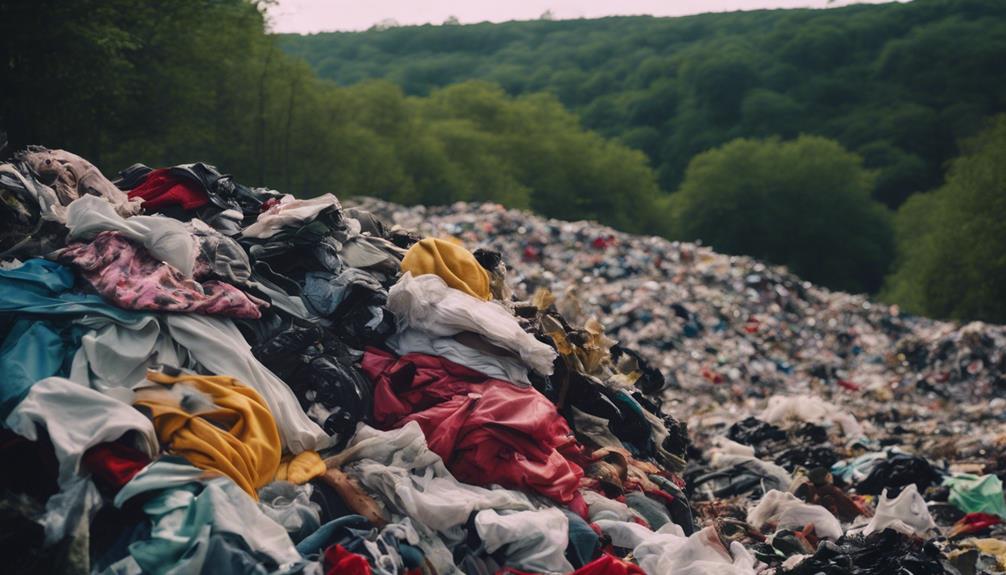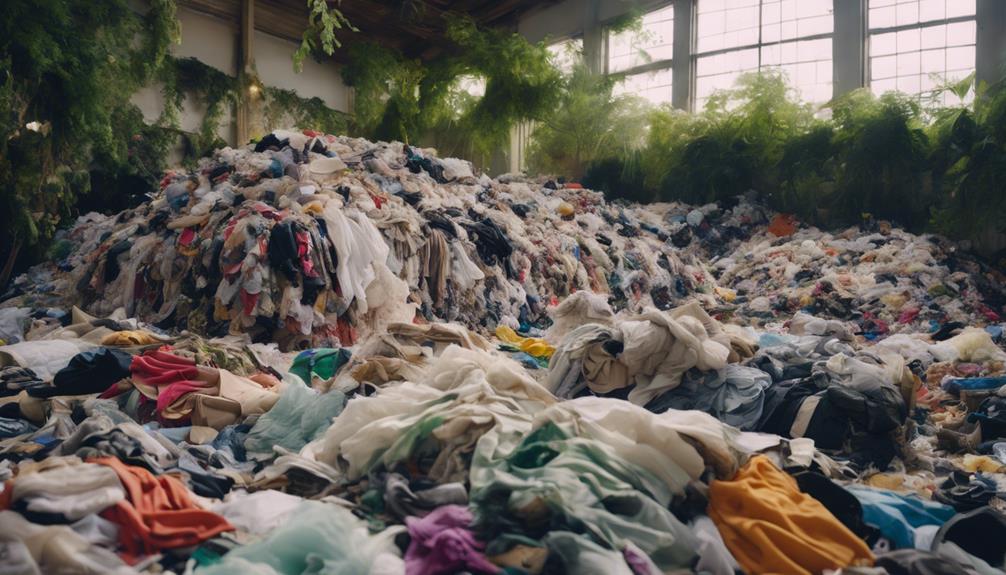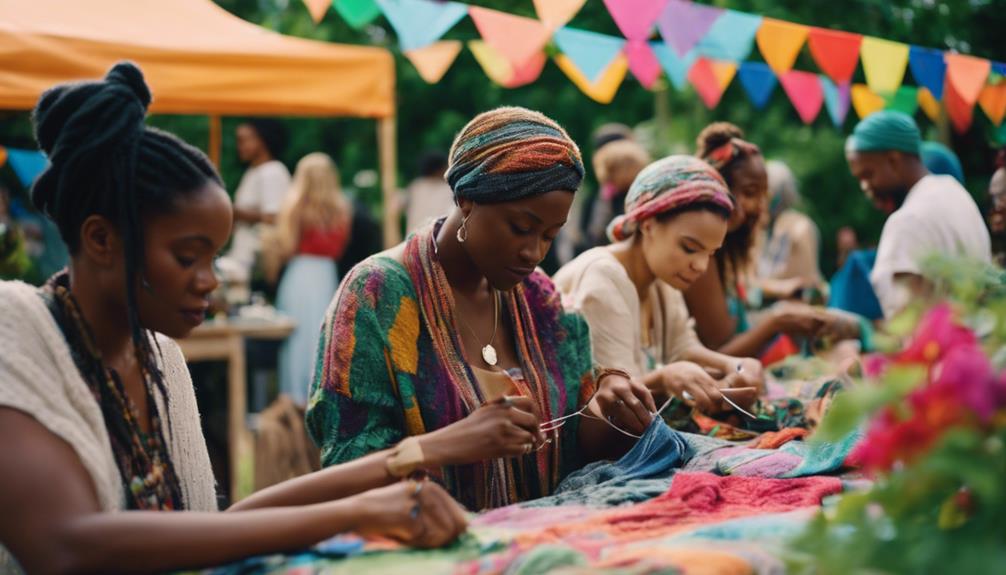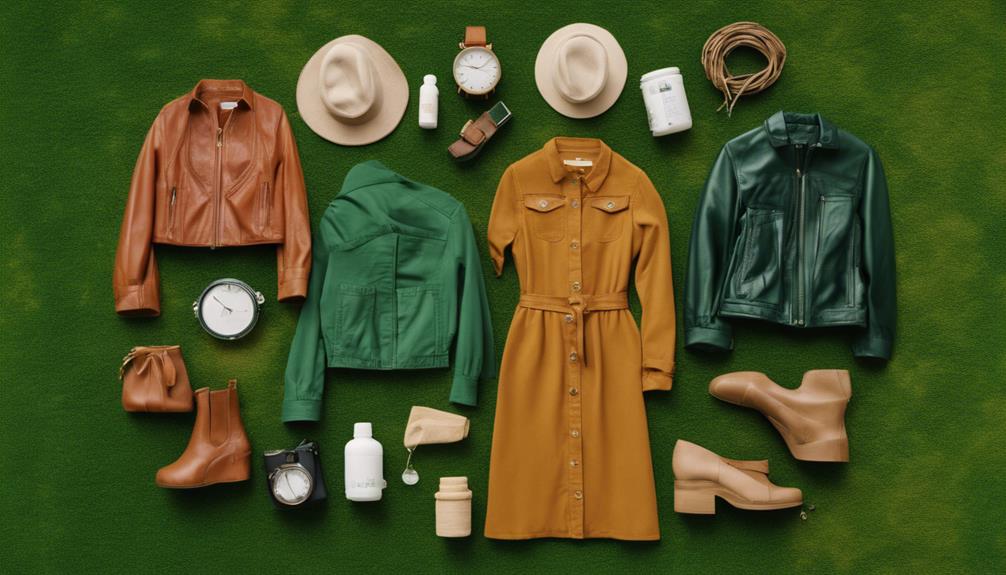Sustainable fashion involves making conscious decisions that benefit both the planet and its people. It places emphasis on eco-friendly sourcing and ethical labor practices, with the goal of reducing the significant waste and pollution generated by fast fashion. Were you aware that the fashion industry is responsible for approximately 10% of global carbon emissions? By opting for sustainable alternatives, you are not only endorsing more responsible practices but also encouraging a shift in consumer behavior. This presents an opportunity to invest in high-quality, long-lasting pieces. Interested in learning more about how these choices impact the environment and your community? There is much to discover on this journey!
Key Takeaways
- Sustainable fashion promotes ecological integrity and social justice, focusing on responsible sourcing and ethical labor practices.
- The fashion industry contributes 10% of global carbon emissions, highlighting the urgent need for sustainable practices.
- Investing in high-quality, durable clothing reduces waste and can save consumers money over time.
- Community initiatives like clothing swaps enhance local bonds while promoting sustainable consumption habits.
Definition of Sustainable Fashion
Sustainable fashion is a movement that champions ecological integrity and social justice throughout the entire fashion system. It's about more than just trendy clothes; it's a holistic approach that considers every aspect of fashion production. When you embrace sustainable fashion, you're not only choosing eco-friendly materials but also supporting ethical fashion practices that prioritize fair treatment for workers and communities.
By focusing on responsible sourcing of raw materials, sustainable fashion seeks to minimize environmental harm. This means opting for natural dyes instead of harmful synthetic ones, reducing toxic exposure for both the planet and garment workers. It encourages you to think about the lifespan of your clothing, promoting durability and reducing waste.
The movement also highlights the interconnectedness of fashion with global sustainability issues, pushing for awareness and change in how consumers and industries operate. When you understand sustainable fashion, you recognize the power of your choices and their impact on the world.
Importance of Sustainable Fashion

Embracing sustainable fashion is crucial for reducing the environmental impact of the industry while promoting ethical practices that benefit workers and communities. By choosing sustainable options, you help balance the negative effects of traditional fashion, which considerably contributes to global carbon emissions. In fact, the fashion industry accounts for about 10% of these emissions, making it essential for you to contemplate the impact of your choices.
When you focus on quality over quantity, you reduce waste, as the average person discards about 37 kg of textiles annually. This shift fosters responsible consumption and production practices. It's encouraging to see that 71% of millennials prioritize sustainability in their shopping habits, driving demand for more ethical fashion choices.
Sustainable fashion empowers you to align your purchases with your personal values, encouraging a cultural shift towards mindfulness in fashion consumption. By supporting brands that prioritize ethical practices, you contribute to a system that values ecological integrity and social justice.
Ultimately, your choices can inspire others and create a ripple effect, making sustainable fashion not just a trend but a necessary movement for the future.
Environmental Impact of Fast Fashion

Fast fashion's impact on the environment is alarming, and you mightn't realize how much it contributes to carbon emissions.
With the industry projected to reach 2.8 billion tons of CO2 emissions annually by 2030, the urgency is clear.
Plus, the staggering amount of textile waste generated each year highlights the need for change in how we approach clothing consumption.
Carbon Emissions Contribution
The fashion industry substantially contributes to climate change, accounting for about 10% of global carbon emissions. Fast fashion items play a significant role in this issue, generating around 1.2 billion tonnes of carbon emissions each year. As you explore your wardrobe, consider that the average clothing piece is worn only seven times before being discarded. This rapid consumption cycle not only increases greenhouse gas emissions but also fuels environmental degradation.
If trends continue, projections suggest that apparel and footwear industries could produce up to 2.8 billion tons of CO2 emissions annually by 2030. Such alarming figures highlight the urgency for sustainable practices in fashion. By 2050, clothing and textiles are expected to account for 26% of the total carbon budget, worsening our already precarious climate situation.
You have the power to make a difference by choosing sustainable brands and reducing your consumption of fast fashion items. Every time you opt for quality over quantity, you contribute to a decrease in carbon emissions, helping protect our planet for future generations. Embrace sustainable fashion, and you'll be playing a part in the solution.
Textile Waste Crisis
Clothing waste is piling up at an alarming rate, with an estimated 60% of items tossed within a year of purchase, straining our landfills and ecosystems. This crisis isn't just about clutter; it's a significant environmental issue. The fast fashion model encourages overconsumption, leading to a staggering 148 million tons of textile waste projected by 2030 if trends continue.
| Impact | Statistic |
|---|---|
| Greenhouse Gas Emissions | 8% of global emissions |
| Clothing Discard Rate | 60% within a year |
| Waste Production by 2030 | 148 million tons |
| Recycling Rate | Less than 1% |
The production processes of fast fashion generate 20% of global wastewater, adversely affecting local ecosystems. You might not realize it, but less than 1% of clothing materials are recycled, resulting in an economic loss of approximately $100 billion annually. To combat this, you can choose ethical and sustainable fashion options. By making informed choices, you help reduce textile waste and promote a healthier planet.
Benefits of Sustainable Fashion

When you choose sustainable fashion, you're not just making a style statement; you're also saving money in the long run with durable, high-quality pieces.
You'll help reduce environmental impact by supporting brands that prioritize eco-friendly practices and ethical labor.
Plus, your choices can contribute to healthier ecosystems for everyone involved.
Long-Term Cost Savings
Investing in high-quality sustainable fashion can save you money over time, as these durable pieces often outlast their fast fashion counterparts by years.
When you choose sustainable and ethical clothing, you're not just making a fashion statement—you're also making a smart financial decision for the long run. A cost analysis shows that durable clothing reduces overall spending on replacements, allowing you to spend less over time.
Think about it: the average person discards about 37 kg of textiles each year, which translates to significant costs from frequently replacing low-quality items.
Environmental Impact Reduction
Sustainable fashion plays an essential role in minimizing the environmental impact of the apparel industry by reducing carbon emissions and waste. The fashion industry is responsible for about 10% of global carbon emissions, with fast fashion contributing a staggering 1.2 billion tonnes each year. By choosing sustainable fashion, you're supporting practices that utilize eco-friendly materials and local production, considerably lowering resource consumption and emissions.
Every year, the average person discards around 37 kg of textiles, leading to a massive waste problem. Sustainable fashion emphasizes quality over quantity, encouraging you to invest in longer-lasting pieces, which means you'll replace items less frequently and contribute to less waste. For instance, producing a single cotton t-shirt requires approximately 2,700 liters of water. Sustainable brands aim to minimize this through water recycling and durable materials.
Moreover, extending the lifespan of your clothing and participating in recycling initiatives can reduce the environmental impact by up to 30% for each garment when used for just nine additional months. By embracing sustainable fashion, you're making a conscious choice to protect the planet for future generations.
Ethical Labor Practices
Choosing sustainable fashion not only helps reduce environmental harm but also prioritizes ethical labor practices that protect workers' rights and well-being. In an industry often marred by exploitation, sustainable brands focus on fair wages and safe working environments. Unlike many fast fashion companies, where workers might earn as little as USD 26 a month, sustainable practices guarantee that employees receive compensation that reflects their labor.
By supporting local production, these brands can directly monitor and improve factory conditions, promoting transparency and accountability. This approach leads to better health outcomes for workers, reducing their exposure to hazardous conditions and toxic chemicals often found in traditional garment manufacturing.
When you choose sustainable fashion, you champion a cultural shift towards responsible consumerism and a deeper respect for human rights within the fashion industry. Ethical labor practices not only uplift workers but also create a ripple effect, inspiring others to prioritize fairness and dignity in production.
Fashion Waste Statistics

As the fashion industry continues to thrive, it also produces staggering amounts of waste, with 60% of clothing items discarded within just a year. This cycle of consumption not only leads to significant fashion waste but also contributes to 8% of global greenhouse gas emissions, exacerbating climate change. You might be shocked to learn that by 2030, the industry is projected to generate an astonishing 148 million tons of waste.
Here's a quick look at some alarming statistics:
| Statistic | Impact |
|---|---|
| 60% of clothing discarded annually | Massive landfill contributions |
| 36% decrease in clothing utilization | Rise of fast fashion culture |
| Less than 1% recycled materials | $100 billion loss in resources |
| 8% of global greenhouse gas emissions | Significant climate change contributor |
The average consumer's clothing utilization has plummeted, reflecting a troubling trend toward disposability. Until we address these pressing issues, the environmental impact of the fashion industry will only worsen, affecting both our planet and future generations.
Innovations in Sustainable Fashion

Embracing innovations in sustainable fashion can transform the industry, offering eco-friendly alternatives that benefit both the environment and consumers. As you explore these advancements, you'll find that brands are actively working to create a more sustainable supply chain.
Here are some key innovations to contemplate:
- Recycled Materials: Patagonia's use of recycled polyester fleece from plastic bottles showcases how waste can be transformed into fashionable garments.
- Natural Fibers: Innovative fibers like Eri silk not only provide luxury but also support sustainable practices in textile production.
- Handcrafted Techniques: The fashion industry is reviving hand-spun and handwoven fabrics, enhancing the uniqueness of garments while promoting traditional craftsmanship.
These innovations contribute to a Zero Waste approach, encouraging recycling and repurposing materials to create new products.
Smart Shopping Practices

Smart shopping practices not only help you make more sustainable choices but also empower you to support ethical brands and reduce fashion waste.
Start by prioritizing thrift and consignment stores; purchasing secondhand clothing cuts down on textile waste and promotes a circular economy in fashion. Research ethical brands before making purchases, as many focus on environmentally-friendly materials and fair labor practices—ensuring your money contributes to positive initiatives.
Avoid fast fashion retailers that harm the environment. Instead, invest in timeless pieces that offer longevity and adaptability, helping you navigate various styles without constantly buying new items. Quality over quantity should be your mantra; high-quality garments last longer, lowering the frequency of purchases and minimizing resource consumption.
Embrace smart shopping habits by evaluating the lifecycle of clothing before you buy. This not only encourages mindful consumption practices but also helps combat climate change by reducing your carbon footprint.
Community-Based Solutions

Community-based solutions like clothing swaps create opportunities for individuals to connect while promoting sustainable fashion practices. These events not only help reduce clothing consumption but also strengthen community networks. When you participate in clothing swaps, you engage with others who share your values, making it a fun and meaningful social activity.
Here are some benefits of clothing swaps:
- Reduce Waste: Exchanging garments helps divert clothing from landfills.
- Build Community: Strengthening local bonds fosters collaboration on sustainable initiatives.
- Save Money: You can refresh your wardrobe without spending a dime.
Future of Sustainable Fashion

How can the fashion industry evolve to meet the growing demand for sustainability while still appealing to consumers?
The future of sustainable fashion lies in innovative materials and eco-friendly production processes. As you shop, you'll notice an increasing number of brands prioritizing sustainable fibers and transparent sourcing. With 71% of millennials considering sustainability in their purchasing decisions, it's clear that you want more than just style; you want eco-conscious choices.
The concept of a circular economy is gaining momentum, encouraging practices like rentals, recycling, and upcycling, which help minimize waste and extend the life of your garments. This approach not only meets your needs but also addresses the alarming projection that the fashion industry could consume 26% of the global carbon budget by 2030.
Industry leaders are stepping up, pledging to adopt sustainable practices that directly reduce global emissions. You'll find that as brands commit to these changes, they'll appeal to your desire for responsible consumption.
The future of sustainable fashion isn't just a trend; it's a critical shift towards a more responsible industry that values both style and the planet.
Frequently Asked Questions
What Is Sustainable Fashion and Why Is It Important?
Sustainable fashion means choosing clothes made from eco-friendly materials and ethical practices. It's important because it reduces waste, lessens environmental impact, and supports fair labor, helping you make a positive difference with your purchases.
What Does Sustainable Fashion Mean to You?
Sustainable fashion means choosing clothes that respect the environment and people. It's about buying less, selecting quality pieces, and supporting ethical brands. You're making a difference by being mindful of your fashion choices.
What Is Sustainable Fashion and Why Should We Care?
Sustainable fashion's like a refreshing change in a crowded room. You should care because it minimizes waste, supports ethical practices, and helps combat climate change, empowering you to make a positive impact with your choices. By choosing sustainable fashion materials, such as organic cotton, recycled polyester, and hemp, you can reduce the environmental footprint of your clothing. These materials are produced with less water, chemicals, and energy, making them a more sustainable option compared to traditional fabrics. Additionally, supporting brands that prioritize sustainable materials can help drive positive change in the fashion industry and encourage others to follow suit.
Do People Really Care About Sustainable Fashion?
Yes, people really care about sustainable fashion. You'll notice more consumers prioritizing eco-friendly choices, pushing brands to adopt ethical practices. Awareness is growing, and many are enthusiastic to make informed, responsible shopping decisions.
Conclusion
Sustainable fashion isn't just a trend; it's a movement that's as essential as the air we breathe. By embracing it, you're not only making stylish choices but also contributing to a healthier planet.
The shift from fast fashion to sustainability is like turning a ship—slow, but powerful. Each conscious decision you make ripples through the industry, inspiring others to follow suit.
Together, we can weave a future where fashion respects both our style and our environment.









